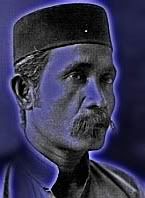This page hasn't been updated since the dawn of Hari Raya, I know. My sincere apologies to you all. Time is flying ever so swiftly and I am now doing the finishing touches to my next book, and I've already decided on its title, A Map of Trengganu. But don't you all start pulling your hair out now and scream in unison, "Oh no! Another?" This will be my last book on Trengganu - well, in this shape and form at least - I can promise you. So be calm, go placidly now and have another bite of the kerepok lekor.
What comes after this? I don't know. Insha Allah, I shall hope to move on to other things. Take the life of Mat Sprong, perhaps, and do a bit of work as private eye.
But in the meantime, to keep this space occupied, here's an extract from one of the chapters, about our house in Kuala Trengganu -
In the central part of our house was a long bookshelf, hung tall between wall and central pillar, and looking from halfway up the wall, gathering much of the dust that blew in from the activities in the pasar, stood Tok Wan, the paterfamilias in his white dress uniform, grim and standing among the
kesumba (annatto) bushes that coloured my fingers red whenever we visited his house in Kampung Raja.
I'd lie on the sofa sometimes past midnight, reading the Dandy or Beano, when distant voices would take me to the back to see Father, still on his mat, deep in prayer. Then he'd rise too to peek into the dark outside as the chanting grew louder. "They're doing the
ratib awör," he'd say. The
ratib was sometimes done by a group of people who'd move about in the village in the quiet hours to chant prayers and
zikr for the peace and well-being of our little community. It was an eerie sound that broke into the night from far away, and even as they came nearer and grew louder, they were still disembodied and unreal to a child.
People in the area often referred to our house as
rumah tinggi, the tall house. It wasn't tall by any earth shattering standards, but it stood on taller legs than the average Trengganu house. From the
surung it gave us a good view of the pasar, and standing at the window each morning we could see a myriad of people go by, the market traders and their baskets of fruit, and South Indian merchants sitting behind heaps of onions, coriander seeds, dried chillies from Madras, and fenugreek; and sugar in jute sacks and kerosene drawn from a metal container with a metal manual pump, screeching metal against metal that gave our teeth a funny feel.
People looking at us from the front of the house do not know what vistas we had from other windows: Pök Wè's tall
mminja trees and one corner of the
surau's roof almost touched our dining room window, we could see the shoreline from another, and from the back of our house we looked down into a dark lane that people seldom used, here we stood back to back to a long row of gloomy-looking ancient houses and the incessant murmur of Pök Anjang the
röjök man, scolding his wife or his workers.
There was always people bantering around the
surau, and the splashings of water from the community well and the
thump!, thump!, thump! of the wooden pounding sticks mashing the fish in those mortars where Mök Nab and Mök Song made
kerepok. The
kuali at Pök Anjang's was always clanging, even when he did not speak, and the voices of women and children were always rising from the lanes and the houses around us, and Hindi songs from distant radios and the blaring public service broadcast from the electric bellow that the Information Department had placed in the upper floor window of Bhiku's café, regular news breaks and song requests from Radio Malaysia.
-------------------------------------------
A Note for the Perplexed: Like GUiT, "A Map of Trengganu" will come with a glossary.



